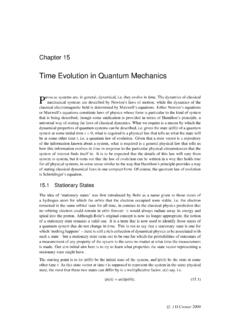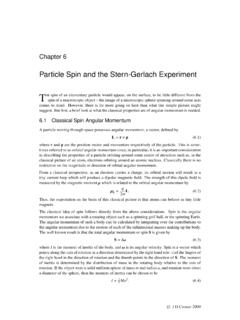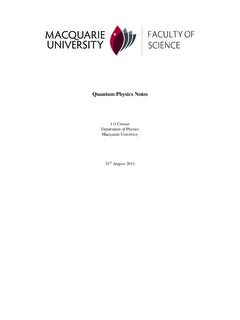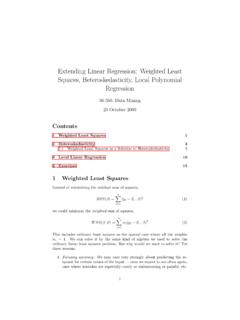Transcription of Probability, Expectation Value and Uncertainty
1 Chapter 14 Probability, Expectation Value and UncertaintyWehave seen that the physically observable properties of a quantum system are representedby Hermitean operators (also referred to as observables ) such that the eigenvalues ofthe operator represents all the possible results that could be obtained if the associated physicalobservable were to be measured. The eigenstates of the operator are the states of the systemfor which the associated eigenvalue would be, with 100% certainty, the measured result, if theobservable were measured.
2 If the system were in any other state then the possible outcomes ofthe measurement cannot be predicted precisely different possible results could be obtained, eachone being an eigenvalue of the associated observable, but only the probabilities can be determinedof these possible results. This physically observed state-of-affairs is reflected in the mathematicalstructure of quantum mechanics in that the eigenstates of the observable form a complete set ofbasis states for the state space of the system, and the components of the state of the system withrespect to this set of basis states gives the probability amplitudes, and by squaring, the probabilitiesof the various outcomes being the probabilistic nature of the measurement outcomes.
3 Familiar tools used to analyze statis-tical data such as the mean Value and standard deviation play a natural role in characterizing theresults of such measurements. The Expectation or mean Value of an observable is a concept takenmore or less directly from the classical theory of probability and statistics. Roughly speaking, itrepresents the (probability- weighted ) average Value of the results of many repetitions of the mea-surement of an observable, with each measurement carried out on one of very many identicallyprepared copies of the same system.
4 The standard deviation of these results is then a measure ofthe spread of the results around the mean Value and is known, in a quantum mechanical context,as the with Discrete ValuesThe probability interpretation of quantum mechanics plays a central, in fact a defining, role inquantum mechanics, but the precise meaning of this probability interpretation has as yet not beenfully spelt out. However, for the purposes of defining the Expectation Value and the Uncertainty itis necessary to look a little more closely at how this probability isoperationallydefined.
5 The waythis is done depends on whether the observable has a discrete or continuous set of eigenvalues, soeach case is discussed separately. We begin here with the discrete an observable for a system with a discrete set of values{a1,a2,..}, then this observableis represented by a Hermitean operator Athat has these discrete values as its eigenvalues, andassociated eigenstates{|an ,n=1,2,3,..}satisfying the eigenvalue equation A|an =an|an .c J D Cresser 2009 Chapter 14 Probability, Expectation Value and Uncertainty191 These eigenstates form a complete, orthonormal set so that any state| of the system can bewritten| = n|an an| where, provided | =1, then| an| |2=probability of obtaining the resultanon mea-suring see what this means in an operational sense, we can suppose that we prepareNidentical copiesof the system all in exactly the same fashion so that each copy is presumably in the same state|.
6 This set of identical copies is sometimes called anensemble. If we then perform a measurementof Afor each member of the ensemble, for each copy, we find that we get randomly varyingresults : 1 2 3 4 5 6 7 8 .. count up the number of times we get the resulta1 call thisN1, and similarly for the numberof timesN2we get the resulta2and so on. ThenNnN=fraction of times the resultanis obtained.( )What we are therefore saying is that if the experiment is performed on an increasingly large num-ber of identical copies, asN , then we find thatlimN NnN=| an| |2.
7 ( )This is the so-called frequency interpretation of probability in quantum mechanics, the prob-ability predicted by quantum mechanics gives us the frequency with which an outcome will occurin the limit of a very large number of repetitions of an is another interpretation of this probability, more akin to betting odds in the sense thatin application, it is usually the case that the experiment is a one-off affair, it is not possibleto repeat the experiment many times over under identical conditions. It then makes more senseto try to understand this probability as a measure of the likelihood of a particular result beingactually observed, in the same way that betting odds for a horse to win a race is a measure of theconfidence there is in the horse actually winning.
8 After all, a race is only run once, so while it ispossible to imagine the race being run many times over under identical conditions, and that theodds would provide a measure of how many of these imagined races a particular horse would win,there appears to be some doubt of the practical Value of this line of thinking. Nevertheless, the probability as frequency interpretation of quantum probabilities is the interpretation that is stillmost commonly to be found in quantum ValueWe can now use this result to arrive at an expression for the average or mean Value of all theseresults.
9 If the measurement is repeatedNtimes, the average will beN1Na1+N2Na2+..= nNnNan.( )c J D Cresser 2009 Chapter 14 Probability, Expectation Value and Uncertainty192 Now take the limit of this result forN , and call the result A : A =limN nNnNan= n| an| |2an.( )It is a simple matter to use the properties of the eigenstates of Ato reduce this expression to acompact form: A = n |an an| an= n | A|an an| = | A{ n|an an|}| = | A| ( )where the completeness relation for the eigenstates of Ahas been result can be readily generalized to calculate the Expectation values of any function of theobservable A.
10 Thus, in general, we have that f( A) = n| an| |2f(an)= |f( A)| ( )a result that will find immediate use below when the Uncertainty of an observable will be the Expectation Value has been defined in terms of the outcomes of measurements of anobservable, the same concept of an Expectation Value is applied to non-Hermitean operatorswhich do not represent observable properties of a system. Thus if Ais not Hermitean and hencenot an observable we cannot make use of the idea of a collection of results of experiments overwhich an average is taken to arrive at an Expectation Value .

















